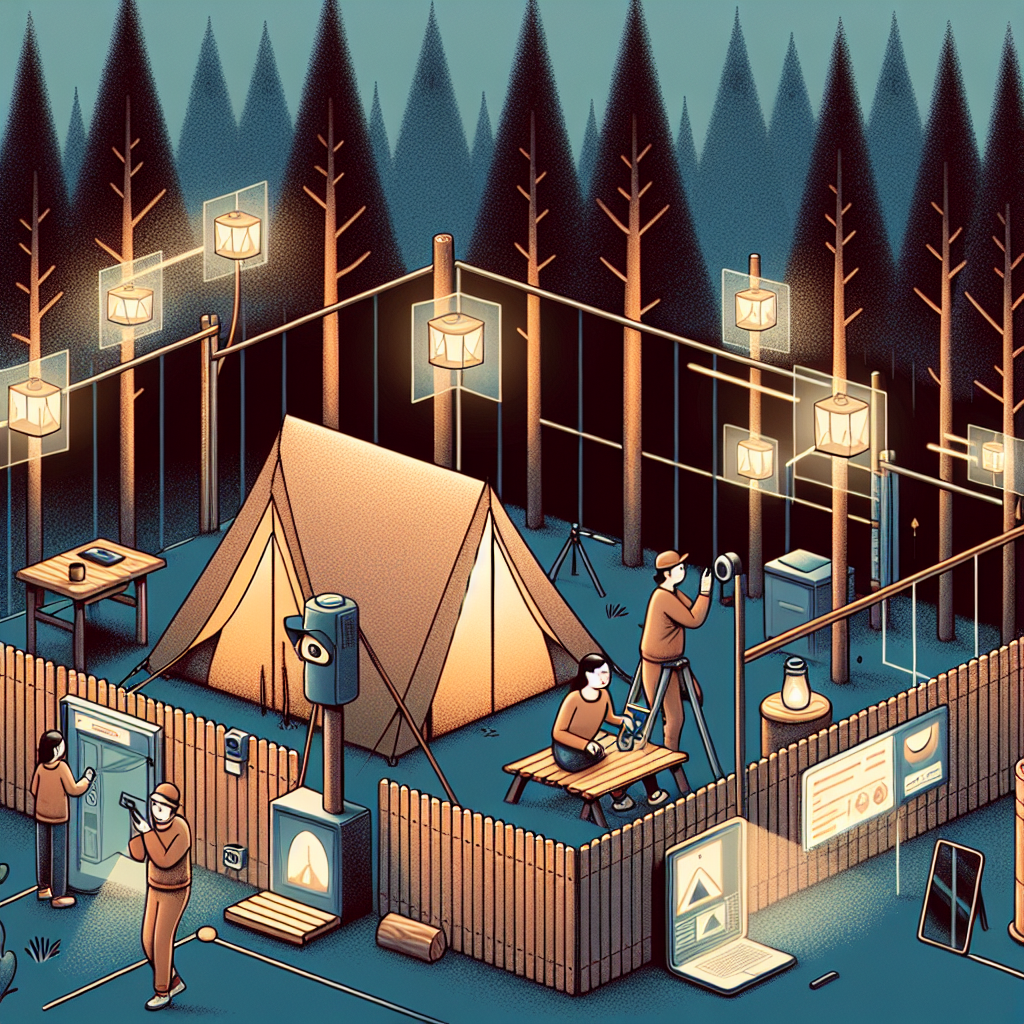Imagine a serene getaway, immersing yourself in the beauty of nature, and reconnecting with loved ones around a crackling campfire. As you embark on this outdoor adventure, it is crucial to prioritize safety. From the rugged mountains to the tranquil forests, this article will equip you with essential tips and measures to ensure the utmost security for your campsite. By implementing effective strategies to secure the perimeter, you can not only protect yourselves and your belongings but also enjoy a worry-free experience in the great outdoors. So, grab your camping gear and get ready to discover the key to a safe and unforgettable outdoor escapade.
Choosing a Safe Campsite Location
Consider the Surroundings
When choosing a campsite location, it is important to carefully consider the surroundings. Look for a site that is situated away from potential hazards such as steep cliffs, unstable trees, or areas prone to flooding. Assess the slope of the land to ensure that rainwater will not accumulate around your campsite. Additionally, consider the proximity to wildlife habitats and sources of water, as these can attract animals that may pose a threat to campers.
Check for Existing Structures
Before setting up your campsite, take a moment to check for any existing structures nearby. Look out for dilapidated buildings or abandoned structures that may pose safety risks. If you come across any, it is best to choose a different location to avoid any potential accidents or hazards.
Evaluate the Accessibility
Another important factor to consider when choosing a campsite location is accessibility. Ensure that you can easily access the site with your equipment and vehicles. Check that the roads leading to the campsite are in good condition and can withstand the weight of your vehicles. It is also beneficial to choose a location that is not too far from emergency services or main roads in case of any emergencies.
Assess the Level Ground
An evenly leveled ground is essential for setting up tents, cooking areas, and other campsite amenities. Ensure that the chosen location offers a flat and stable ground to prevent any discomfort during your camping experience. Avoid areas with too many rocks, uneven terrain, or slopes that can make it difficult to set up campsites and can pose a safety hazard.
Ensure Sufficient Space
Consider the size of your camping group and the amount of equipment you will be bringing when choosing a campsite location. Make sure there is enough space to comfortably accommodate everyone and set up camp without feeling cramped. Having adequate space will not only ensure comfortable and safe camping, but it will also provide room for emergency exits and maneuvering in case of any unforeseen circumstances.
Setting Up Visible Boundaries
Utilize Rope or Tape
One of the simplest ways to establish visible boundaries around your campsite is by using rope or tape. These can be easily tied between trees or stakes to mark the perimeter of your campsite. Make sure that the boundaries are clearly visible and easily distinguishable, especially at night, to prevent any accidental trespassing or confusion.
Place Signage
To further reinforce the boundaries of your campsite, consider placing signage indicating that the area is private property or a designated campsite. These signs can help deter unauthorized individuals from entering your campsite and ensure that campers and visitors are aware of the defined boundaries.
Use Brightly Colored Flags
Brightly colored flags can be an effective way to make your campsite boundaries highly visible from a distance. Plant these flags at regular intervals around the perimeter of your campsite to clearly mark the boundaries. This will act as a visual cue for campers and passersby to respect the designated area.
Install Temporary Fencing
In certain situations, particularly when camping in areas with a high number of visitors or where wildlife activity is common, installing temporary fencing can be a practical solution to secure your campsite. Temporary fencing can help deter animals and prevent unwanted visitors from entering your campsite while still maintaining a welcoming and open atmosphere.

Installing Secure Campsite Entry Points
Implement Restricted Access
To enhance security, consider implementing restricted access to your campsite. Establish clear entrance points and ensure that only authorized individuals have access to the campsite. This can be done through a registration process, requiring campers to provide identification or passes upon arrival.
Use Lockable Gates
Installing lockable gates at the entry points of your campsite can significantly increase security. Lockable gates provide an added layer of protection against unauthorized entry and give campers a sense of privacy and safety.
Install Combination Locks
Combination locks are an effective way to secure entry points while allowing authorized individuals access to the campsite. By sharing the combination with campers or designated personnel only, you can ensure that only those with the code can enter the site.
Implement Key Card System
For larger campsites or facilities that require a more sophisticated security system, implementing a key card system can be beneficial. Each camper or individual receives a key card that grants them access to the campsite. This system allows for easy monitoring of who enters and exits the premises, providing an additional level of security.
Lighting the Campsite
Choose Appropriate Lighting
Proper lighting is essential for maintaining a safe and secure campsite. Choose lighting options that are suitable for outdoor use and provide adequate illumination. LED lanterns, headlamps, and flashlights are great options for personal lighting, while larger floodlights or overhead lighting can be installed at common areas within the campsite.
Install Motion-Activated Lights
Motion-activated lights are an excellent option for enhancing security at your campsite. These lights will automatically turn on when motion is detected, alerting campers to any activity in the vicinity. By installing motion-activated lights at entry points, pathways, and around common areas, you can deter potential intruders and improve overall safety.
Utilize Solar-Powered Lights
Solar-powered lights offer an environmentally friendly and cost-effective lighting option for campsites. These lights absorb sunlight during the day and store energy to be used at night. By strategically placing solar-powered lights around your campsite, you can ensure a well-lit environment during darker hours without relying on traditional power sources.
Consider Timers for Lighting
To conserve energy and maintain a routine lighting schedule, consider using timers for your campsite lighting. Timers can be programmed to automatically turn on lights at dusk and turn them off at a predetermined time, ensuring that the campsite remains well-lit throughout the night while minimizing energy consumption.

Creating Fire Safety Measures
Designate Fire Pit Areas
When camping, fire safety is of utmost importance. Designate specific areas for campfires and ensure they are set up in safe locations away from flammable materials, low-hanging branches, and tents. Clearly mark these fire pit areas and enforce the rule that fires should only be lit within these designated zones.
Provide Fire Extinguishers
Having readily accessible fire extinguishers is crucial for ensuring quick and effective response to any fire emergencies. Place fire extinguishers at various locations within the campsite, especially close to fire pit areas. Regularly inspect and maintain the extinguishers to ensure they are fully functional and ready for use.
Clear Vegetation Around Campfires
To prevent the spread of fires, it is essential to clear vegetation, dry leaves, and other combustible materials from the area surrounding the campfires. Maintain a buffer zone free from flammable debris to minimize the risk of accidental fires spreading beyond control.
Educate Campers on Fire Safety
Educating campers on fire safety practices is paramount to prevent accidents and ensure a safe camping experience. Provide information and guidelines on fire safety, including proper fire starting techniques, safe fire management, and the importance of extinguishing fires completely before leaving the campsite. Make campers aware of potential fire dangers and encourage them to report any fire hazards they may come across.
Establishing a Communication System
Provide Emergency Contact Information
Make sure to provide campers with emergency contact information, including the nearest medical facilities, police stations, and park rangers’ offices. Display this information prominently at the campsite and encourage campers to save it on their mobile devices for easy access in case of emergencies.
Install Two-Way Radios
Two-way radios are valuable communication tools for maintaining contact within the campsite. Install base stations at key locations and provide each camping group or individual with a handheld radio. This allows for quick and efficient communication in case of emergencies, ensuring that assistance can be sought promptly.
Designate a Communication Center
Establish a designated area within the campsite as a communication center. This area can be equipped with phones, radios, and other communication devices to serve as a centralized hub for campers to relay important messages or seek assistance. Clearly mark the communication center to ensure everyone is aware of its location in case of emergencies.
Create Communication Plans
Develop communication plans that outline procedures for different emergency scenarios. Define who should be contacted, how messages should be relayed, and any specific protocols to be followed. Distribute these communication plans among campers to ensure everyone understands their roles and responsibilities in emergency situations.
Implementing Security Personnel or a Watch System
Hire Security Guards
For larger or high-security campsites, it may be necessary to hire professional security guards to ensure the safety and well-being of campers. Security guards can patrol the premises, monitor activities, and quickly respond to any security concerns. Their presence alone can act as a deterrent to potential intruders or unruly behavior.
Recruit Volunteers for Watch Duty
If hiring security guards is not feasible, consider recruiting volunteers from among the campers to serve as a watch system. Establish shifts during which volunteers take turns patrolling the campsite, reporting any suspicious behavior or safety concerns. This community watch system can promote a sense of collaboration and responsibility among campers.
Establish Security Shifts
If implementing a watch system, it is crucial to establish clear and regular security shifts. Divide the day and night hours into manageable shifts and assign responsibilities accordingly. Ensure that each shift is adequately staffed and that volunteers or designated personnel are present at all times to maintain campsite security.
Monitor Campsite Activity
Continuous monitoring of campsite activity is essential to promptly detect any security breaches or emergencies. Encourage security personnel or volunteers to maintain visual presence and to report any unusual or suspicious behavior. Regularly communicate with the monitoring team to ensure all potential security concerns are addressed promptly.
Utilizing Surveillance and Alarm Systems
Install Security Cameras
Installing security cameras in strategic locations around the campsite can provide an additional layer of security. Surveillance cameras act as a deterrent to potential intruders and can help monitor activity within the campsite. Ensure that the cameras are visible, clearly marked, and provide adequate coverage to capture all key areas of the premises.
Implement Intrusion Detection Systems
Intrusion detection systems are designed to detect any unauthorized access to the campsite. These systems use various sensors, such as motion detectors or beam-break detectors, to identify potential intruders. When triggered, the system can sound an alarm, issue an alert, or notify security personnel, enabling immediate response and intervention.
Utilize Perimeter Alarms
Perimeter alarms are specifically designed to secure the boundaries of the campsite. These alarms can be wired or wireless and can be set to trigger an alarm if someone crosses the defined perimeter. Perimeter alarms serve as an effective early-warning system, notifying campers and security personnel of any potential breaches.
Consider Mobile Surveillance
In areas where permanent infrastructure is not feasible or during temporary camping events, mobile surveillance units can be a valuable security measure. These units are equipped with cameras, alarms, and communication systems, allowing for flexible deployment. Mobile surveillance can be especially useful in remote areas or during special camping events that require heightened security measures.
Encouraging Campers to Secure Their Belongings
Educate Campers on Personal Security
Promote a culture of personal security among campers by providing information and resources on how to keep their belongings safe. Educate them about the importance of keeping valuables out of sight and securing their personal items at all times. Encourage campers to be vigilant and report any suspicious activities or individuals to the appropriate authorities.
Promote the Use of Locks
Encourage campers to use locks to secure their tents, RVs, or camping equipment when not in use. High-quality padlocks or combination locks can act as an effective deterrent against theft and provide campers with peace of mind knowing that their belongings are secure.
Provide Storage Boxes
Consider providing storage boxes or lockers within the campsite where campers can securely store their valuables. These storage facilities can be locked and accessible only to authorized campers, ensuring that personal items are kept safe and protected.
Suggest Marking Personal Items
Encourage campers to mark their personal items with unique identifiers, such as their names or distinctive symbols. This can make it easier to identify and recover stolen or misplaced items. Additionally, suggest keeping an inventory of valuable possessions to assist with insurance claims in case of theft or loss.
Regularly Inspecting and Maintaining the Perimeter
Conduct Regular Inspections
Regular inspections of the campsite perimeter are essential to identify any weaknesses or vulnerabilities in the security measures. Walk the entire perimeter and assess the condition of fencing, signage, lighting, and other security features. Look out for any signs of damage, wear and tear, or breaches that need immediate attention.
Repair or Replace Damaged Fencing
If any sections of the campsite fencing are damaged or compromised, it is crucial to repair or replace them promptly. A sturdy and intact perimeter fence is an essential component of campsite security. Regularly inspect the fencing and address any issues to ensure that the boundary remains secure.
Maintain Lighting Systems
Proper maintenance of lighting systems is essential for ensuring that the campsite remains well-lit and secure. Regularly check and replace bulbs, clean solar panels, and repair any faulty wiring or connectors. Conduct routine checks to ensure that all lighting fixtures are functioning optimally to maintain a safe and well-illuminated environment.
Monitor Security Systems’ Functionality
Keep a close eye on the functionality of the installed security systems, including cameras, alarms, and other surveillance equipment. Regularly test the systems to ensure that they are operating as intended. Replace batteries, conduct firmware updates, and perform necessary maintenance tasks to keep the security systems in optimal working condition.
In conclusion, securing a campsite involves a multi-faceted approach that considers various factors to ensure the safety and well-being of campers. By choosing a safe campsite location, setting up visible boundaries, installing secure entry points, providing adequate lighting, implementing fire safety measures, establishing a communication system, deploying security personnel or watch systems, utilizing surveillance and alarm systems, encouraging campers to secure their belongings, and regularly inspecting and maintaining the perimeter, campsite organizers and campers can create a secure environment for an enjoyable and worry-free camping experience. Remember, safety should always be a top priority when setting up and enjoying your campsite.

